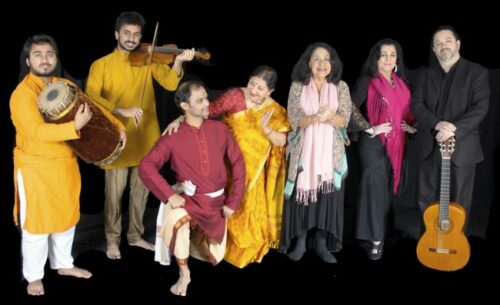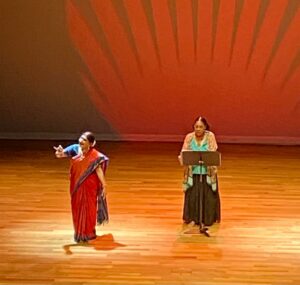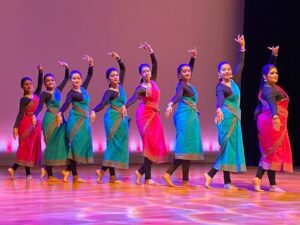From Hardship to Hope

A Story, A Song, and a Dance at Asia Society Texas Center, March 26, 2022
Concept and Choreography by Rathna Kumar
Storytelling by Jean Donatto
Flamenco by singer Irma La Paloma and guitarist Jeremy Garcia
Indian music by violinist Abhishek Balakrishnan and percussionist Naga Srinidhi
Indian Classical Dance by Rathna Kumar, Venugopal Josyula, and the Anjali Dance Company
Artists of all stripes, though perhaps most of all performing artists, have felt the hardships brought on by the COVID-19 pandemic, and as we cautiously emerge from it, we’ve begun to see artworks reflecting these two years. In A Story, A Song, and a Dance, Rathna Kumar of Samskriti Indian Performing Arts instigated a collaboration that dived into the heart of that hardship but also pointed the audience to a future full of creativity and hope.
 The arc of the evening was fairly simple. We started in the days just before the pandemic. Storyteller Jean Donatto gives us a brief intro to the evening, and then is replaced onstage by the eight young women of the Anjali Dance Company, five dressed in teal saris, three dressed in red. The dancers first portray what appears to be school girls, playing games with one another. Kumar enters and stops the playing and has the dancers sit in rows, facing the Indian musicians, stationed on the left side of the stage. They learn a song from the musicians, Abhishek Balakrishnan singing a line, which is then repeated by the young women. After their music lesson, Venugopal Josyula, dressed in teal top and yellow pants (one of the great joys of Indian dance is how colorful it is), enters as a dance teacher. At the end of the dance lesson, though, Kumar returns, gestures as though looking out a window at something coming, which disturbs her. The young women exit, one by one, and eventually Josyula also sees the threat coming. All of them are replaced by Irma La Paloma, who sings with all the drama and emotion you expect from Flamenco, accompanied by Jeremy Garcia, who is seated on the right-hand side of the stage. While knowing the languages used onstage, including the gestures of the Indian dance, might have illuminated what one saw, no one could doubt that we had moved into the time of the pandemic and all the isolation and disruption it brought to our lives.
The arc of the evening was fairly simple. We started in the days just before the pandemic. Storyteller Jean Donatto gives us a brief intro to the evening, and then is replaced onstage by the eight young women of the Anjali Dance Company, five dressed in teal saris, three dressed in red. The dancers first portray what appears to be school girls, playing games with one another. Kumar enters and stops the playing and has the dancers sit in rows, facing the Indian musicians, stationed on the left side of the stage. They learn a song from the musicians, Abhishek Balakrishnan singing a line, which is then repeated by the young women. After their music lesson, Venugopal Josyula, dressed in teal top and yellow pants (one of the great joys of Indian dance is how colorful it is), enters as a dance teacher. At the end of the dance lesson, though, Kumar returns, gestures as though looking out a window at something coming, which disturbs her. The young women exit, one by one, and eventually Josyula also sees the threat coming. All of them are replaced by Irma La Paloma, who sings with all the drama and emotion you expect from Flamenco, accompanied by Jeremy Garcia, who is seated on the right-hand side of the stage. While knowing the languages used onstage, including the gestures of the Indian dance, might have illuminated what one saw, no one could doubt that we had moved into the time of the pandemic and all the isolation and disruption it brought to our lives.
 The evening plays out this way, with the different artists taking turns onstage, expressing many feelings that people experienced as the world shut down. As they take turns however, there are also moments of sharing the stage, particularly as they start finding joy again, the slow emergence from the hardships. Notable among them are when Kumar dances as Donatto tells a story of a boy who becomes the friend of the Sun, or when La Paloma gives Kumar a bright red, fringed shawl. These exchanges take us to the end of the performance, with the urging to keep hope alive.
The evening plays out this way, with the different artists taking turns onstage, expressing many feelings that people experienced as the world shut down. As they take turns however, there are also moments of sharing the stage, particularly as they start finding joy again, the slow emergence from the hardships. Notable among them are when Kumar dances as Donatto tells a story of a boy who becomes the friend of the Sun, or when La Paloma gives Kumar a bright red, fringed shawl. These exchanges take us to the end of the performance, with the urging to keep hope alive.
As noted before, about the various languages used onstage, so much was conveyed without having to know every word spoken. Even if no languages were understood, the movement, the music, even the tone of voice in the storytelling conveyed so much of our collective experiences of the last two years.
Which leads me to this observation. In pre-show materials and in the talkback after the show, Kumar emphasized the universality of all art forms to speak across cultures and languages. That these three sets of artists from three distinct cultures collaborated toward a unified production is noteworthy. As I’ve reflected on the experience, however, I would say she and her collaborators accomplished something else as well. Though we all experienced some level of isolation in the early days of the pandemic, it was not an isolated event. Every culture and language has experienced it and has a response to it. A Story, A Song, and a Dance gives us a hint of what may still be in store for us, what artists from around the world may yet have to show us.



Recent Comments